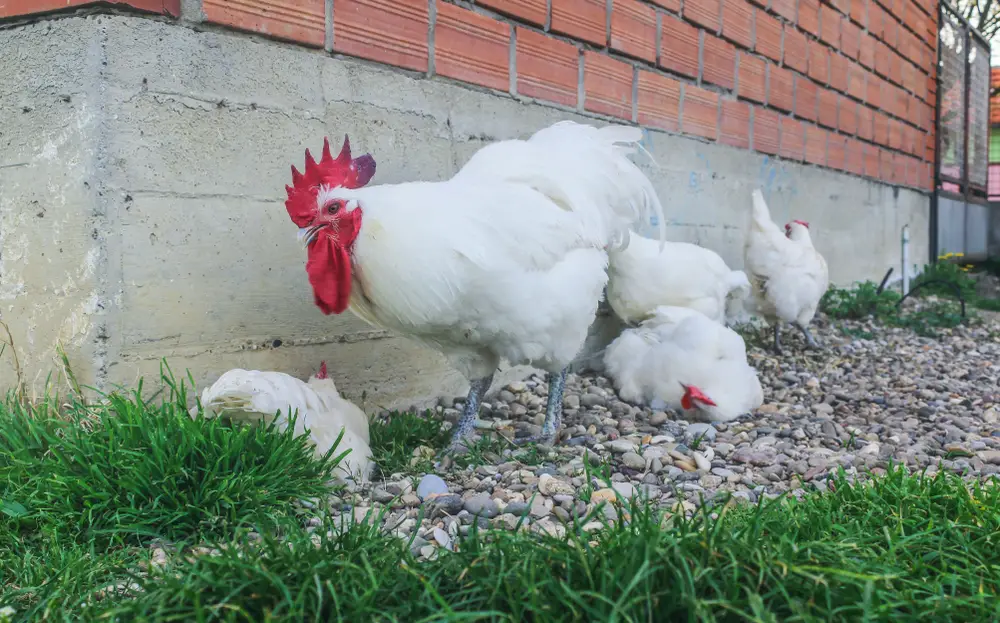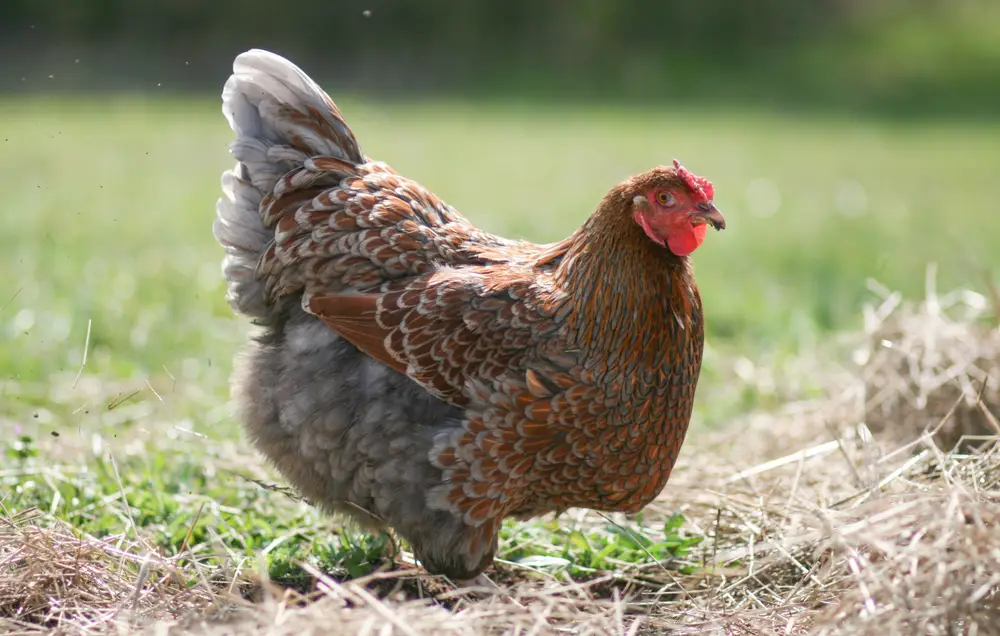Blue chickens do not have true blue feathers, but rather have a grey appearance and feathers that are outlined in a darker shade of grey, particularly on the head and neck area. Some of their blue plumage may appear as a slate blue color, but most often they are solid gray.
Blue chickens are actually black chickens that have an incomplete dominant gene acting on the genotype of the bird, producing a chicken that has gray rather than black feathers.
They aren’t newcomers on the block either. This color variation has been occurring in chicken breeds for hundreds of years.
There are many different chicken breeds that have this color mutation occurring naturally, and while they may be called “Blue Chickens”, they are actually a blue variety of a black chicken breed.
Table of Contents
Blue Chicken Breeds to Consider
Luckily there are numerous Blue Chicken breeds worth considering if you’re interested in adding Blue Chickens to your backyard flock.
The most popular Blue Chicken varieties are:
The Blue Cochin Chicken
Blue Cochin chickens are adorable balls of fluff with lofty wings and body feathers. They tend to be large, and were originally bred as broilers with roosters weighing up to 11lbs.

| Temperament | A wonderful, easy going, docile, and friendly chicken Great for beginners |
| Egg Color | Light to dark brown |
| Egg Size | Medium |
| Egg Production | 50 to 180 eggs annually |
Blue Andalusian Chickens
Blue Andalusians are winter egg layers! This small-statured chicken is adaptable to many climates and is a naturally healthy and hardy breed originally from Europe.

| Temperament | Highly active, intelligent and inquisitive Able to be trained and love treats They are not cuddly and love to explore A large chicken run is required |
| Egg Color | White eggs |
| Egg Size | Large |
| Egg Production | 20 to 150 eggs per year |
Blue Ameraucana Chickens
Blue Ameraucana chickens can come as either a standard Blue or a Blue Wheaten type. They have adorable chubby looking chipmunk faces, with muffs and beards.
Bantam varieties exist in addition to standard for both color types and are officially recognized by the American Poultry Association (APA).

| Temperament | Somewhat unpredictable though generally friendly These chickens do not like being held, but do love to forage and explore |
| Egg Color | Blue eggs |
| Egg Size | Medium |
| Egg Production | 50 to 175 eggs per year |
Blue Silkie
Blue Silkies are soft and have the fluffiest appearance of all chickens due to the lack of barbicels in their feathers. These friendly birds are often kept as pets and are regularly in attendance at poultry shows.
There are both standard and bantam varieties of Blue Silkies.
| Temperament | Friendly and easy to handle, great for beginners Hens are often broody and will not willingly give up their eggs |
| Egg Color | White to tinted – it can vary |
| Egg Size | Extra small |
| Egg Production | 100 to 120 eggs per year |
Blue Copper Maran
These lovely chickens are originally from France and are a cold-hardy breed. Their feathers are blue gray with a cuckoo type pattern.

| Temperament | Generally sweet and docile though some have an independent streak |
| Egg Color | Dark brown |
| Egg Size | Medium |
| Egg Production | 150 to 250 eggs per year |
Blue Sumatra
This lovely chicken has a unique appearance amongst all the Blue chicken varieties and roosters have an ornamental, signature tail that shimmers gray/blue. They are primarily used in poultry shows, as they do not have a lot of meat and are not good egg layers.
| TemperamentSimilar to wild pheasants Not friendly and prefer solitude | |
| Egg Color | White |
| Egg Size | Small |
| Egg Production | 50 eggs per year |
Blue Australorp
Blue Australorps are from Australia and are a large, dual-purpose bird. Beloved worldwide, they are known for their shiny, iridescent feathers.
The blue color variation doesn’t occur often in Australorps, so Blue Australorps are rare and may be difficult to find.

| Temperament | Family friendly chickens perfect for backyard flocks |
| Egg Color | Light brown |
| Egg Size | Medium to large |
| Egg Production | 250 to 300 eggs per year |
Blue Bresse Gauloise
This French breed is a dual-purpose breed with beautiful gray and a few iridescent green feathers and is a fairly new breed variety with most Bresse Gauloise being white.
They have distinctive blue feet and are used primarily as meat birds, known for their tender, delicious meat which is fat marbled, the same as beef.

| Temperament | They are birds that aren’t particularly docile and may seem aloof |
| Egg Color | White |
| Egg Size | Large |
| Egg Production | 200 eggs per year |
Delaware Blue
Delaware Blue hens are gorgeous little chickens with feathers that look like chain-link armor! While they aren’t officially recognized by the APA, these chickens have been around for a few hundred years.

| Temperament | Varies depending on the bird Most are inquisitive and talkative, though not overly friendly. |
| Egg Color | Brown |
| Egg Size | Medium |
| Egg Production | 220 to 250 eggs per year |
Blue Dutch Bantam
Blue Dutch Bantams are used in many poultry shows and while considered a showbird, they also are decent egg-layers.
| Temperament | Friendly and docile Great chicken for children and beginners |
| Egg Color | Brown |
| Egg Size | Medium |
| Egg Production | 150 eggs per year |
Blue Plymouth Rock Chickens
These lovely birds are a cross between a Plymouth Rock and Blue Andalusian chicken. They are an excellent dual-purpose breed.

| Temperament | Friendly if raised with affection towards their keepers Fairly active and inquisitive |
| Egg Color | Light brown |
| Egg Size | Large |
| Egg Production | 200 to 300 eggs per year |
Blue Laced Red Wyandotte Chicken
Blue Wyandotte chickens are renowned for their beauty and are dual-purpose chickens. They have slate blue feathers, with bright red combs, wattles, and earlobes.
Blue Wyandottes are decent egg producing chickens and will continue producing in winter months.

| Temperament | Easy to handle Fairly friendly and affectionate with people They love to forage |
| Egg Color | Light brown |
| Egg Size | Large |
| Egg Production | 200 eggs per year |
Blue Orpington
Blue Opringtons are large, dual-purpose chickens with distinctive blue/gray feathers. They come in standard and bantam varieties.
| Temperament | Easy going lap chickens who love to be held Are especially docile |
| Egg Color | Light brown |
| Egg Size | Large |
| Egg Production | 150 to 250 eggs per year |
Feeding, Coop and Health
Blue chickens need around 15 square feet of chicken coop space per chicken with multiple perches and places to roost. Any laying hens will require nesting boxes with a minimum size of 12 x 12 and should not house more than 3 hens at a time.
If your hens are broody, you can count on them to sit on their eggs and you may not need an incubator in your hatchery, but if they aren’t broody, be sure to have an incubator ready!
Blue baby chicks will also require a brooder after they are born that should feature a safe source of heat, with a chick waterer and feeder.
Health concerns will vary depending on the chicken breed. Most modern breeds are fairly hardy and are only susceptible to ectoparasites and chicken lice, though some breeds may be prone to certain health issues and require preventative care.
Feed requirements will also vary depending on the age, sex, and weight of your chickens.
Blue chicks should be offered chick starter as a crumble or mash after they are born.
Once a blue chick reaches 6 weeks old, they will require grower feed to develop into a cockerel or pullet. Grower feed is specifically developed to help chickens grow quickly and has all the nutrients they will require at this stage of life.
Blue hens should be given layer feed after they begin laying eggs that has 16% to 18% protein. Oyster shell should be offered to help supplement calcium intake.
Blue roosters can eat the same layer feed as hens but should not be offered oyster shell.
Your flock should have unrestricted access to chicken grit so they can digest the food they are eating as chickens cannot process food without grit.
Blue chickens will also love having table scraps including fresh fruits and veggies from time to time. Ensure that anything you choose to give them is safe for them to eat and does not make up more than 10 percent of their total diet.
FAQs
Are Blue Hens actually Blue?
No. They are actually gray in appearance but have a blue colored gene acting on a black chicken which gives them a gray or blue/gray appearance.
How Many Eggs do Blue Chickens Lay?
Blue hens tend to be average egg layers and most produce between 120 and 200 eggs per year. Compared with other egg production breeds, they are consistent with most egg laying backyard chickens.
Typical production is 2 to 4 medium size per week, but most blue hens will not lay during the winter months.
What is a Common Misconception about Blue Chickens?
One of the most common assumptions people make about blue chickens, is that all of their eggs are blue. This is not true of most blue chicken varieties but it is true of Blue Ameraucana hens!
What Colors are the Eggs Blue Chickens Lay?
It varies! Some varieties will produce brown eggs, white eggs, or even blue eggs! Each chicken breed has different egg production and egg color capabilities.

